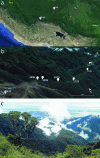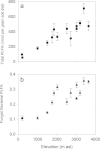Climate Warming and Soil Carbon in Tropical Forests: Insights from an Elevation Gradient in the Peruvian Andes
- PMID: 26955086
- PMCID: PMC4777015
- DOI: 10.1093/biosci/biv109
Climate Warming and Soil Carbon in Tropical Forests: Insights from an Elevation Gradient in the Peruvian Andes
Abstract
The temperature sensitivity of soil organic matter (SOM) decomposition in tropical forests will influence future climate. Studies of a 3.5-kilometer elevation gradient in the Peruvian Andes, including short-term translocation experiments and the examination of the long-term adaptation of biota to local thermal and edaphic conditions, have revealed several factors that may regulate this sensitivity. Collectively this work suggests that, in the absence of a moisture constraint, the temperature sensitivity of decomposition is regulated by the chemical composition of plant debris (litter) and both the physical and chemical composition of preexisting SOM: higher temperature sensitivities are found in litter or SOM that is more chemically complex and in SOM that is less occluded within aggregates. In addition, the temperature sensitivity of SOM in tropical montane forests may be larger than previously recognized because of the presence of "cold-adapted" and nitrogen-limited microbial decomposers and the possible future alterations in plant and microbial communities associated with warming. Studies along elevation transects, such as those reviewed here, can reveal factors that will regulate the temperature sensitivity of SOM. They can also complement and guide in situ soil-warming experiments, which will be needed to understand how this vulnerability to temperature may be mediated by altered plant productivity under future climatic change.
Keywords: decomposition; soil microorganisms; soil organic matter; temperature sensitivity; tropical lowland forest; tropical montane forest.
Figures






Similar articles
-
Leaf litter decomposition rates increase with rising mean annual temperature in Hawaiian tropical montane wet forests.PeerJ. 2014 Dec 4;2:e685. doi: 10.7717/peerj.685. eCollection 2014. PeerJ. 2014. PMID: 25493213 Free PMC article.
-
Microbial responses to warming enhance soil carbon loss following translocation across a tropical forest elevation gradient.Ecol Lett. 2019 Nov;22(11):1889-1899. doi: 10.1111/ele.13379. Epub 2019 Sep 6. Ecol Lett. 2019. PMID: 31489760
-
The origin of soil organic matter controls its composition and bioreactivity across a mesic boreal forest latitudinal gradient.Glob Chang Biol. 2018 Feb;24(2):e458-e473. doi: 10.1111/gcb.13887. Epub 2017 Sep 27. Glob Chang Biol. 2018. PMID: 28871609
-
Influences of evergreen gymnosperm and deciduous angiosperm tree species on the functioning of temperate and boreal forests.Biol Rev Camb Philos Soc. 2015 May;90(2):444-66. doi: 10.1111/brv.12119. Epub 2014 Jun 11. Biol Rev Camb Philos Soc. 2015. PMID: 24916992 Review.
-
Decoupling the direct and indirect effects of climate on plant litter decomposition: Accounting for stress-induced modifications in plant chemistry.Glob Chang Biol. 2018 Apr;24(4):1428-1451. doi: 10.1111/gcb.13923. Epub 2018 Jan 28. Glob Chang Biol. 2018. PMID: 28986956 Review.
Cited by
-
Effects of short-term warming and nitrogen addition on the quantity and quality of dissolved organic matter in a subtropical Cunninghamia lanceolata plantation.PLoS One. 2018 Jan 23;13(1):e0191403. doi: 10.1371/journal.pone.0191403. eCollection 2018. PLoS One. 2018. PMID: 29360853 Free PMC article.
-
Extent of Night Warming and Spatially Heterogeneous Cloudiness Differentiate Temporal Trend of Greenness in Mountainous Tropics in the New Century.Sci Rep. 2017 Jan 25;7:41256. doi: 10.1038/srep41256. Sci Rep. 2017. PMID: 28120949 Free PMC article.
-
Distinct Elevational Patterns and Their Linkages of Soil Bacteria and Plant Community in An Alpine Meadow of the Qinghai-Tibetan Plateau.Microorganisms. 2022 May 19;10(5):1049. doi: 10.3390/microorganisms10051049. Microorganisms. 2022. PMID: 35630491 Free PMC article.
-
Elevational patterns of microbial species richness and evenness across climatic zones and taxonomic scales.Ecol Evol. 2023 Oct 9;13(10):e10594. doi: 10.1002/ece3.10594. eCollection 2023 Oct. Ecol Evol. 2023. PMID: 37818244 Free PMC article.
-
Drivers of tropical soil invertebrate community composition and richness across tropical secondary forests using DNA metasystematics.Sci Rep. 2020 Oct 28;10(1):18429. doi: 10.1038/s41598-020-75452-4. Sci Rep. 2020. PMID: 33116157 Free PMC article.
References
-
- Averill C, Turner BL, Finzi AC. Mycorrhiza-mediated competition between plants and decomposers drives soil carbon storage. Nature. 2014;505:543–545. - PubMed
-
- Bardgett RD, van der Putten WH. Belowground biodiversity and ecosystem functioning. Nature. 2014;515:505–511. - PubMed
-
- Billings SA, Ballantyne F. How interactions between microbial resource demands, soil organic matter stoichiometry, and substrate reactivity determine the direction and magnitude of soil respiratory responses to warming. Global Change Biology. 2012;19:90–102. - PubMed
LinkOut - more resources
Full Text Sources
Other Literature Sources

